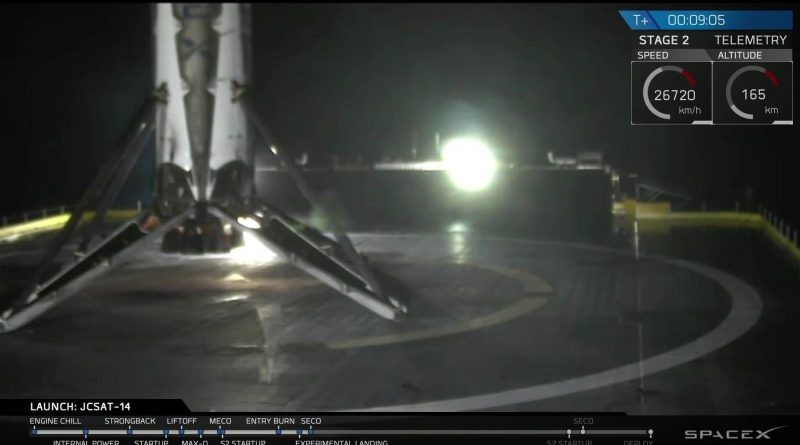Falcon 9 completes high-energy Satellite Delivery, First Stage aces Drone Ship Landing
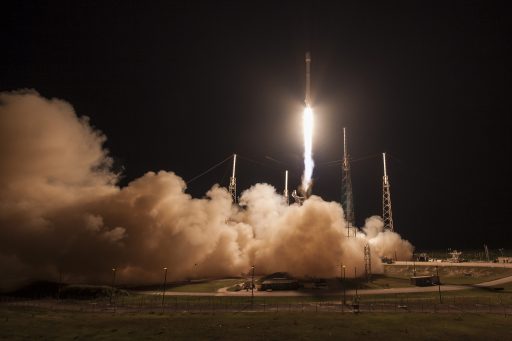
A SpaceX Falcon 9 rocket lit up the night skies over Florida’s Space Coast in the early morning hours on Friday, lifting the JCSat-14 communications satellite to orbit and mastering a challenging high-energy return of the rocket’s first stage to land on the Autonomous Spaceport Drone Ship deployed to the Atlantic Ocean.
The 70-meter tall rocket lifted off at the opening of its launch window at 5:21 UTC, 1:21 a.m. local time and quickly climbed into the dark skies over Cape Canaveral, starting a trek to the south-east along the standard route to Geostationary Transfer Orbit. Thundering off, Falcon 9 ascended with a thrust of nearly 700 metric-ton-force delivered by its nine Merlin 1D engines that fired for just over two and a half minutes to accelerate the rocket to over six times the speed of sound.
Handing off duties to the second stage, the booster began its adventurous landing maneuver while the MVac engine of the upper stage continued pushing the stack into a preliminary parking orbit. A second firing of the second stage, less than one minute in duration, successfully lifted the high-point of the orbit, allowing JCSat-14 to be sent off on a 15-year mission 32 minutes after launch.
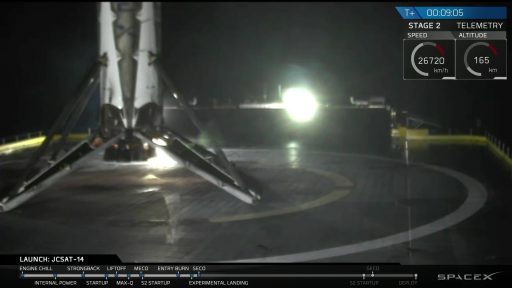
Bracing for a high-energy re-entry, the first stage flipped around and continued on a ballistic arc until re-starting a trio of its engines to hit the brakes and use the engine plume to shield its aft section. After surviving the extreme heating of entry, the booster started a two-minute descent through the atmosphere, controlling its flight path with four actuated grid fins ahead of a do-or-die landing burn. Igniting three engines just seconds prior to impact, the first stage slowed down, deployed its four landing legs and touched down on the ASDS.
Landing 660 Kilometers from Cape Canaveral eight and a half minutes after launching, the booster remained upright to become SpaceX’s third recovered rocket stage, and the first to achieve the feat after a high-energy orbital delivery. Landing with minimal propellant margins will be critical for SpaceX’s future business model of regularly re-flying first stages, requiring a successful recovery on the majority of missions, including those with tight propellant margins.
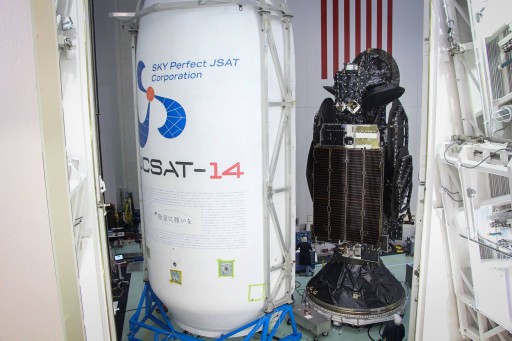
JCSat-14, operated by Sky Perfect JSAT based in Japan, was manufactured by Space Systems/Loral, California, becoming the 102nd satellite based on the company’s LS-1300 satellite platform to be delivered. The spacecraft has a dry mass of 2,180 Kilograms and weighs 4,696 Kilograms at liftoff. Though lighter than SES-9 launched by Falcon 9 earlier this year, the satellite and its target orbit still demanded a significant portion of available performance from Falcon 9.
Outfitted with 26 C-Band and 18 Ku-Band transponders, JCSat-14 will replace the JCSat-2A satellite at a position of 154°E as the older satellite is approaching the end of its service life. JCSat-14 will deliver high-speed connectivity to maritime and aviation customers, high-capacity communications via Ku-Spotbeam coverage over Japan, and broadcasting & networking services delivered via C-Band. The coverage zone of JCSat-14 stretches from Russia over the Asia-Pacific region to Hawaii.
JCSat-14 was originally set for liftoff in the second half of 2015, but the failure of Falcon 9 during the Dragon SpX-7 mission led to a multi-month stand-down in launch operations until the vehicle’s return to flight back in December with the Orbcomm 2 mission, the inaugural flight of the new Falcon 9 FT.
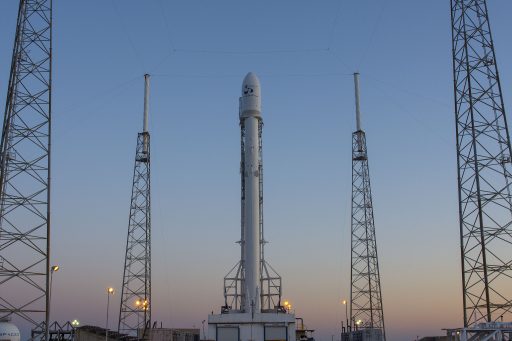
Falcon 9 FT introduces the Merlin 1D engines running at an up-rated throttle setting around 16% higher than the initial M1D owed to design margins allowing thrust to be increased after sufficient certification testing. SpaceX CEO Elon Musk said earlier this week that a further increase of thrust on the Merlin 1D engine is planned later this year due to good performance of the engine in flight and delta-qualification testing clearing the thrust to be increased to 845 Kilonewtons at sea level.
The Full Thrust Version of the Falcon 9 consumes densified sub-cooled Liquid Oxygen and chilled Kerosene, increasing the propellant mass that can fit into the limited tank volume. Compared to the Falcon 9 v1.1, the vehicle features stretched tanks on the second stage and a large interstage section, facilitating a modified MVac engine with a larger nozzle to improve its vacuum performance.
Falcon 9 was rolled to the pad in the morning hours and went vertical a short time later, being hooked up to ground support systems to head into a lengthy countdown when being powered up for a multi-hour testing campaign taking the vehicle from T-10 to T-2 hours. While checks and reconfigurations were underway, teams at the pad were responsible for closing out all facilities for liftoff before departing the complex around four hours prior to launch.
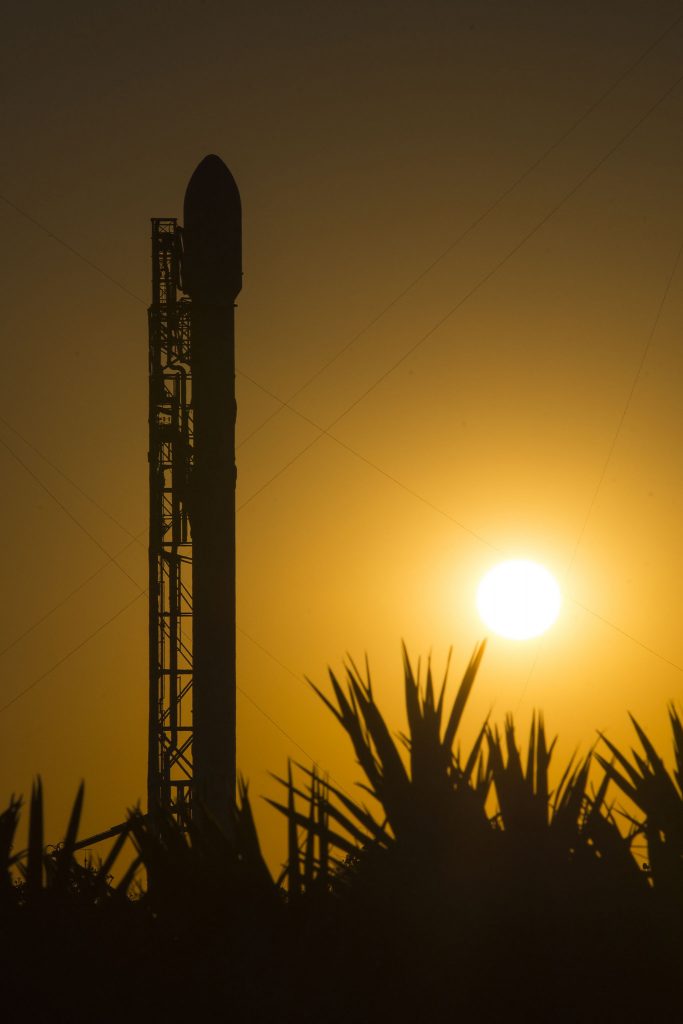
At the Morrell Operations Center, controllers initiated the Eastern Range Countdown at L-4 hours with the setup of range instrumentation before starting to watch over corridor clearance and working through tracking checks with the Falcon 9.
With a clean bill of health, Falcon 9 headed into the business end of the countdown when passing T-1 hour.
At T-38 minutes, the launch team was polled for a Go/No Go to head into the Automated Countdown Sequence. Falcon 9 picked up terminal count at T-35 Minutes, marking the start of the expedited propellant loading sequence implemented to load the tanks as close to liftoff as possible in order to avoid propellants warming up and becoming less dense.
Rocket Propellant 1 started flowing into both stages at T-34:30, chilled to -7°C. Just a minute later, the first stage entered Liquid Oxygen loading as the -207°C oxidizer was pumped into the vehicle through interfaces in the launch mount. In a sequence that only includes around a minute of margin, the second stage entered LOX load at T-19:30 followed by Helium loading six minutes later. Over 500 metric tons of propellant were being pumped into the rocket while other systems went through their final reconfigurations ahead of liftoff.
JCSat-14 made its transition to internal power and went to launch mode around 20 minutes ahead of liftoff with the spacecraft team voicing a final GO to the launch team. With ten and a half minutes on the countdown clock, Falcon 9 started chilling down its nine Merlin 1D engines followed by the setup of the ignition systems and gimbal checks on the first and second stage. The Strongback structure was retracted from the rocket three and a half minutes before launch and the Flight Termination was armed for liftoff as milestones were checked off on the countdown net by the various launch controllers.
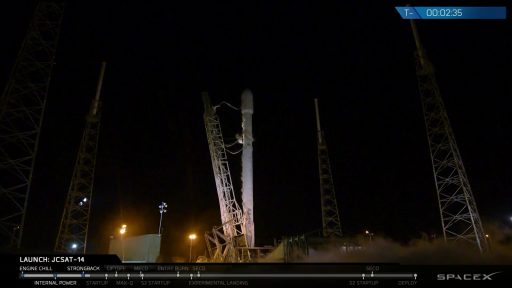
Loading of Liquid Oxygen closed out just 2.5 minutes ahead of T-0 on the first stage and right at the 2-minute mark on the second stage, coinciding with Falcon 9 heading to internal power. Falcon 9 assumed full control of the countdown at T-1 minute, overseeing the pressurization of tanks and counting down to engine ignition at T-3 seconds.
The typical green flame of the TEA-TEB igniter mixture erupted from the base of the Falcon 9 when the nine Merlin 1D came to life and throttled up to a collective liftoff thrust of 694 metric ton force, closely monitored by computers to confirm a good ignition prior to committing Falcon 9 to flight.
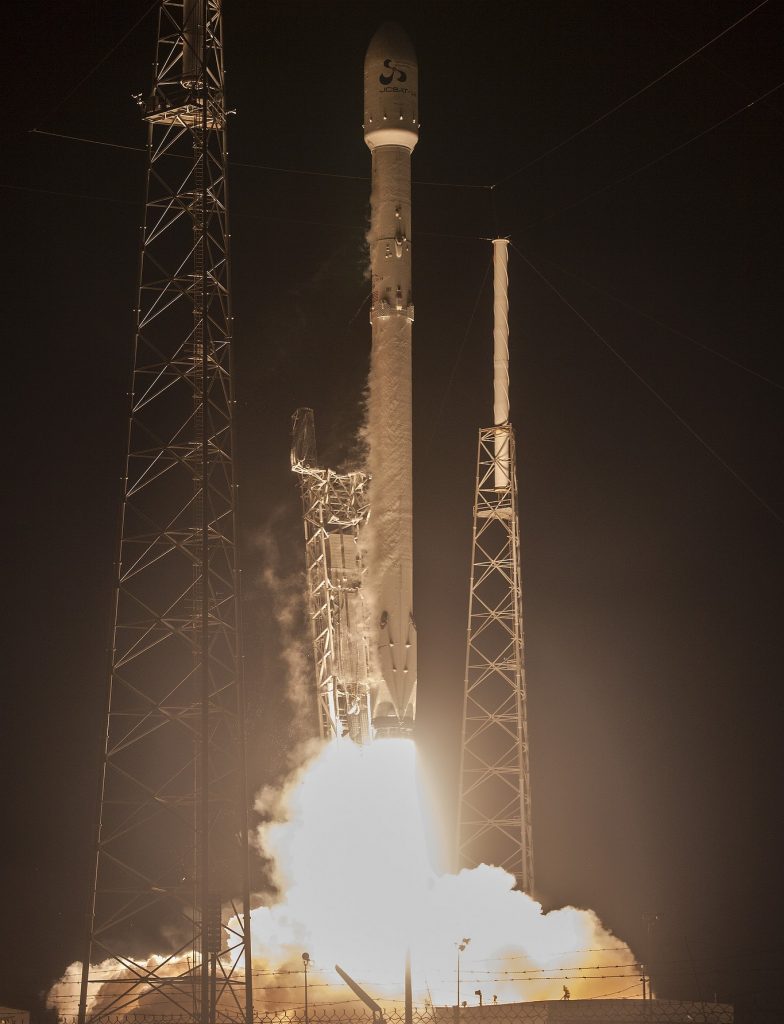
Liftoff came at the opening second of the window at 05:21:00 UTC and the 549-metric-ton Falcon 9 quickly rose from its launch pad, providing a spectacular sight in a clear night as it began its pitch and roll maneuvers to get aligned with a south-easterly trajectory. Heading uphill, the vehicle enabled Propellant Utilization, actively adjusting the mix of propellants delivered to the engines to ensure an optimized consumption of propellant.
Guzzling down 2,465 Kilograms of propellants each second of powered flight, Falcon 9 pushed through the speed of sound 70 seconds after lifting off, still easily visible in the clear night sky. Passing Maximum Dynamic Pressure 80 seconds into the flight, Falcon 9 throttled its engines back for around 20 seconds to limit stress on the vehicle.
While its counterparts on the first stage were still in action, the MVac engine on the second stage initiated its in-flight chilldown to be ready for ignition.
The first stage finished its burn two minutes and 38 seconds into the flight and four pneumatic pushers conducted a clean stage separation just three seconds later. Immediately after clearing the MVac engine, the first stage started firing its cold gas thrusters to embark on its return journey.
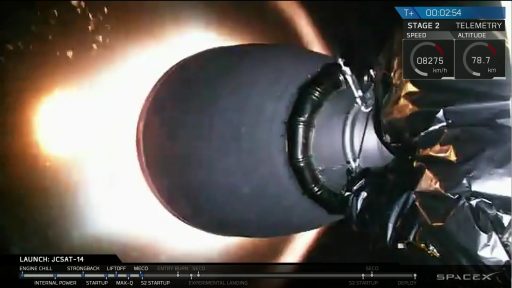
The second stage’s MVac engine started breathing fire at T+2 minutes and 49 seconds, soaring to a thrust of up to 95 metric-ton force to lift the stack into orbit in an initial burn planned to last six six minutes and four seconds. Just around 45 seconds into the burn of the second stage, Falcon 9 had reached an altitude of 115 Kilometers, making it safe to jettison the large 13-meter long payload fairing. With the fairing making a clean departure, JCSat-14 was revealed for the rest of its journey into orbit.
Continuing its south-easterly trek, the second stage performed flawlessly throughout its burn, heading into Terminal Guidance Mode towards the end of the firing to ensure an on-target insertion into a slightly elliptical Low Earth Parking Orbit. Shutdown on the second stage was nominal and the vehicle headed into an 18-minute coast.
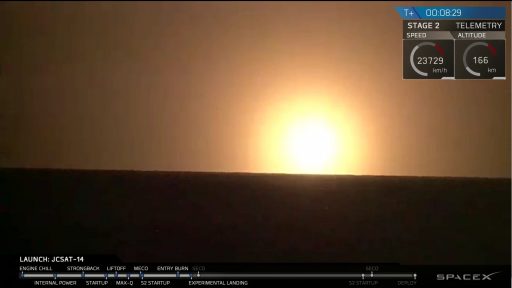
While the second stage reached its preliminary orbit, the journey of the first stage ended dramatically in the dark of night out in the Atlantic Ocean. After departing the upper stage, the booster successfully maneuvered to an engines-first posture, continuing on a ballistic arc until re-entry as no propellant was available for a boost back burn – creating a particularly challenging re-entry environment with extreme temperatures having to be endured by the vehicle.
At the point of re-entry, the first stage fired up at trio of Merlin 1D engines to burn for around 15 seconds to slow the vehicle down and shield the aft section from the most extreme environments. Telemetry from the booster remained nominal after re-entry for the start of a two-minute descent through the atmosphere.
Having deployed its four actuated grid fins, the first stage controlled its angle of attack to modify its downrange travel distance and also corrected any cross track errors to reach a good position for the critical landing burn.
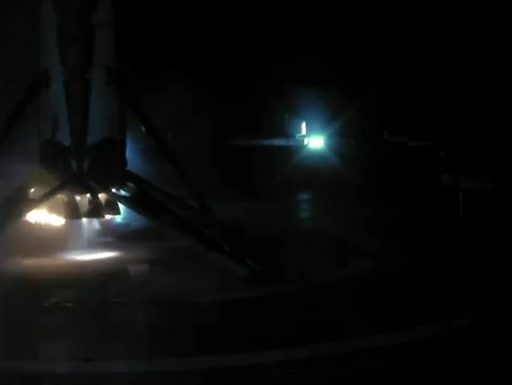
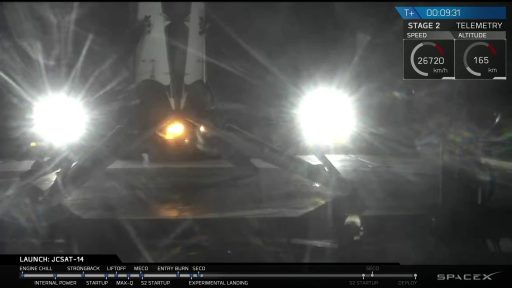
Given the margins available for this mission, SpaceX had to opt for a three-engine landing maneuver, previously referred to as ‘suicide burn’ due to the almost non-existent margins for any transients at engine start or sluggishness of thrust build-up given the short duration of the burn. On the SES-9 mission, the maneuver was unsuccessful due to the booster running out of fuel resulting in a hard impact on the Drone Ship.
The three-engine burn is favored for fuel-limited missions since it cuts gravity losses compared to a more controlled single-engine burn that requires a burn time of around 35 seconds.
Coming in hot, the first stage deployed its landing legs and started three Merlin 1D engines just over ten seconds prior to landing – not giving the vehicle much time to make any last corrections to its trajectory.
With an extremely high thrust-to-weight ratio, the first stage slowed down rapidly until shutting down the two outer engines and completing the last leg of the descent under the power of its center engine alone to achieve the required landing accuracy. The booster touched down in the center of the landing platform at T+8 minutes and ~35 seconds.
A small fire was seen at the base of the stage which has been observed on previous SpaceX landings.
The successful touchdown was met with exhilaration at SpaceX Headquarters where a small crowd of SpaceX employees had gathered to watch the launch despite the late night hour. Remote safing of the stage was started by the launch team and engineers are expected to board the Drone Ship later to secure the stage for a multi-day trip back to Port Canaveral.
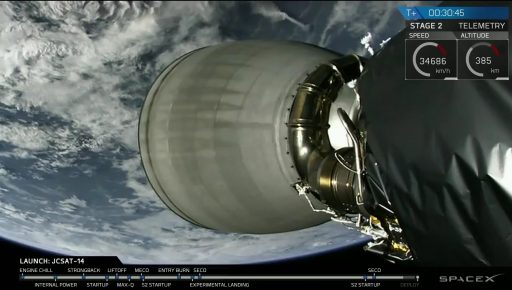
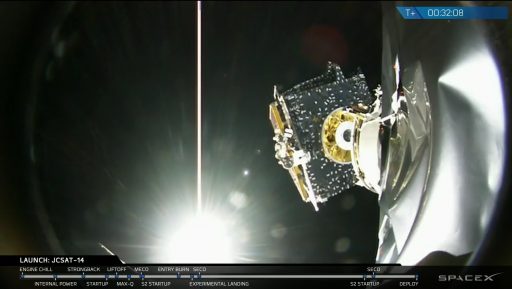
While the first stage conducted its do-or-die landing attempt, the second stage continued the primary mission, coasting towards the equator ahead of the critical second burn of the flight. The 18-minute coast phase was implemented to position the apogee of the insertion orbit above the equator to ease the process of transitioning JCSat-14 to Geostationary Orbit.
MVac successfully re-started 26 and a half minutes into the flight and fired just shy of one minute to significantly raise the apogee of the orbit. Immediately after the conclusion of the burn, the second stage re-oriented for spacecraft separation and dampened body rates before sending JCSat-14 on its way right at the T+32-minute mark. Onboard video showed the satellite making a clean separation and heading off on its 15-year mission.
Friday’s mission was the fourth of the Falcon 9 FT rocket with two prior successes in landing first stages, the first in the December mission with OG2 that achieved the first booster landing at Landing Zone-1 at Cape Canaveral, and the second on the previous SpaceX mission with the Dragon SpX-8 spacecraft, becoming the first successful touchdown on the Autonomous Spaceport Drone Ship.
These two missions, however, had plenty of propellant margin and allowed Falcon 9 to conduct boost-back maneuvers, control its re-entry speed and land with a controlled single-engine burn, a luxury missions to Geostationary Transfer Orbit do not have. Having recovered a core after a high-energy return will provide SpaceX with valuable information on how the various systems responded to the more extreme entry environments to learn lessons for future landing attempts.

